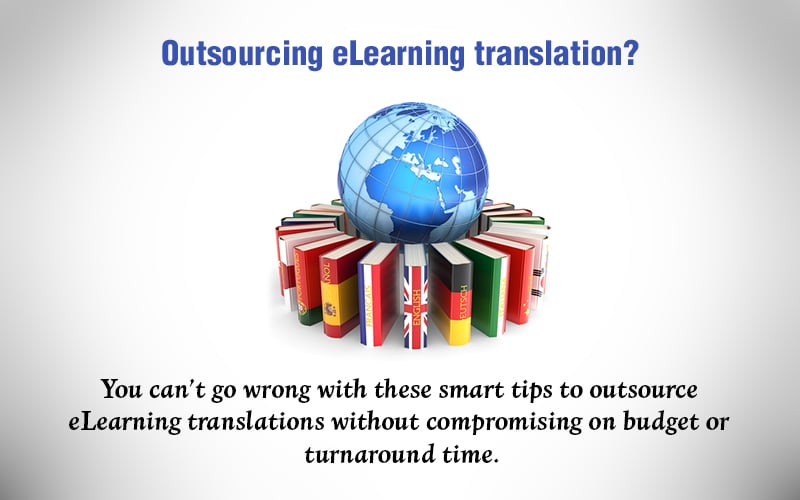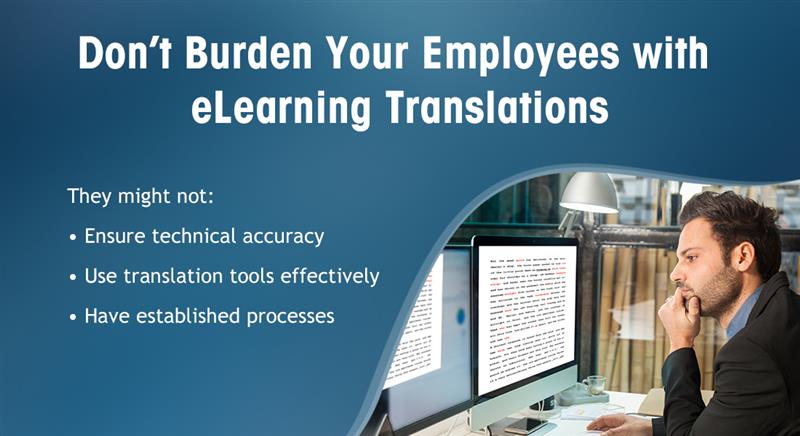Scripting a Successful ‘eLearning Translation Outsourcing’ Story

Most corporate businesses today have a global presence, which means a geographically and culturally diverse workforce. Online training has become the ‘go to’ mantra to meet their training requirements. So, what’s the catch? The ‘catch’ is that your standard English eLearning courses may not be what your globally dispersed employees are looking for. Even if they understand and are reasonably familiar with the nuances of the English language, there may be a lot of linguistic and cultural barriers to overcome. There is nothing like offering your employees training in the language of their choice. That is where eLearning translation comes in – to train your global employees in their native language – for maximum ROI!
eLearning Translation
5 tips for successful outsourcing
- Plan for translation in advance
- Select a trustworthy vendor
- Set-up an in-house team for review
- Create a glossary and style guide
- Ask for a prototype
But how do you go about developing multilingual online training courses? Designing and developing an eLearning course is a formidable task in itself, unless you have the required expertise. Add translations to the mix, and you have chaos – with you running around for multiple linguists, translators, experts in multiple languages, and a lot of tools.
So, what do you do if you want impeccably translated multilingual eLearning courses without compromising on the budget or the turnaround time? You should look for an experienced vendor and outsource your eLearning translations to them!
And here are some smart steps to follow while outsourcing your eLearning translation.
5-Point Checklist for Outsourcing eLearning Translation
1. Plan for Translation Well in Advance
Whether you are planning to translate your existing eLearning courses or develop new multilingual courses, you need a roadmap for the project timeline.
You’ll need to allocate budget based on the volume of courses that needs translation. Plan enough time for finding the right vendor to outsource eLearning translation. Even after selecting the vendor you’ll need to plan for reviews and deliverables. Tighter turnaround time mean higher costs. Preparing a roadmap will help you save time while ensuring the project stays within budget.
Consider your target audience, their linguistic diversity, foreign market, your brand messaging etc., and zero down on the languages to which your eLearning courses need to be translated to.
2. Select a Trustworthy Vendor for Translation
There is no dearth of vendors in the market who undertake eLearning translation projects. But selecting the right one for your requirements is extremely important. Here are a few things you must consider while looking for an outsourcing vendor for eLearning translation.
Choose an experienced vendor with an L&D background offering translation as one of its core services (as we are talking about corporate online courses here): A vendor who is a ‘Jack of all trades but master of none’ offering translation as a small part of its many services will bring down the quality of translation. Similarly, a vendor offering translation as a core service but with no experience in developing eLearning will not do. So, select a vendor whose core business is providing online training translation services.
Determine the vendor’s experience in handling translation projects in various languages: Check how many translation projects (in the languages relevant to your project) the vendor has carried out, and how good they are.
Check the vendor’s expertise in developing multilingual eLearning courses: Look at their reputation in the industry; ask for sample translation projects and case studies before making your final decision.
Determine the vendor’s expertise with the latest technology for rapid eLearning design and translation: eLearning course development and translation requires many technological tools and processes. Check whether the authoring tools they use are translation-friendly and whether they will carry out the translation process using a translation memory tool.
Check the vendor’s project management process: An agile project management process ensures timely reviews and deliverables. Also ensure they have a skilled and trustworthy person managing your entire project who will remain in constant communication at every step of the project.
Compare the pricing per translated eLearning module offered by various vendors and select the vendor providing the most cost-effective solution.
Download this eBook on eLearning design and development outsourcing.
3. Set-up an In-house Team for Review
Selecting a vendor for translation might seem like a challenging task, but your job doesn’t end there, and does not mean you can wash your hands off the entire project. You’ll need to set up a team of SMEs and language experts to carry out a thorough review of the translated courses.
Both SMEs and language experts are needed for quality analysis. SMEs will bring in the domain knowledge and language experts will check the linguistic aspects such as grammar, typos, omissions, and additions in the translated eLearning courses.
4. Create a Glossary and Style Guide for the Vendor
A glossary is a list of industry specific terms that will help the translator. A style guide, on the other hand, will shed light on the tone of the content and your business specific branding.
Both the glossary and style guide will help translators to maintain consistency across translated eLearning courses. You will need the both your SMEs and language experts to create the glossary and style guide for the vendor.
5. Ask for a Prototype of the Translated Course
A prototype is a mini version of an eLearning course with all visual and functional elements in place. Checking the prototype will give you a preview of what the eLearning course will look and feel like.
A prototype of the translated eLearning course will let you check if the translated courses are consistent and have a user-friendly GUI. It will also allow you to determine if the content is visible and readable, does not include any culturally offending element, and if the voice-over is clear with the right pronunciations. It will also allow the time to fix bugs and glitches in the early stages.
Summing It Up!
Outsourcing eLearning translation might be one of the best solutions for your business. You don’t have to burn a hole in your pocket by investing in various tools or hiring an entire team of language experts to carry out the project. You get the benefits of expert eLearning developers and translators while saving on time and money. Isn’t that a dream come true?
Are you now sold on the prospect of outsourcing your eLearning translations? We offer you this insightful whitepaper to help you understand the experiences and perceptions of different businesses on developing cross-cultural eLearning. So, go ahead and take a look.





